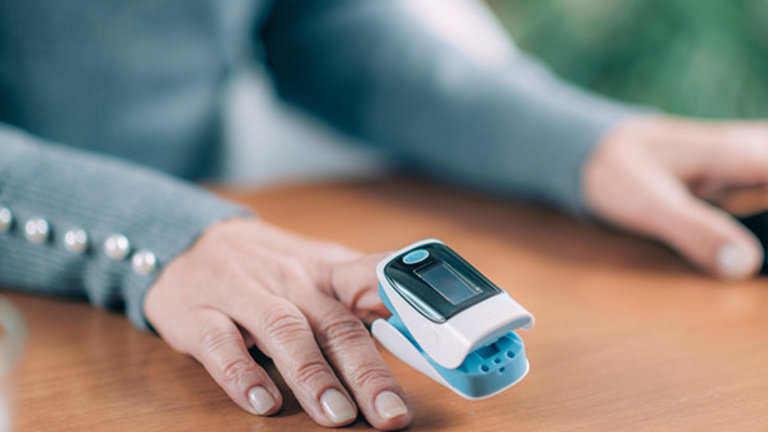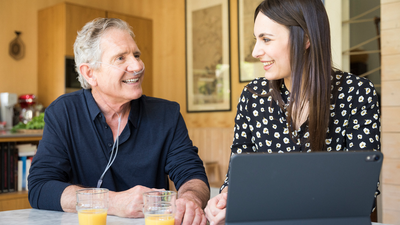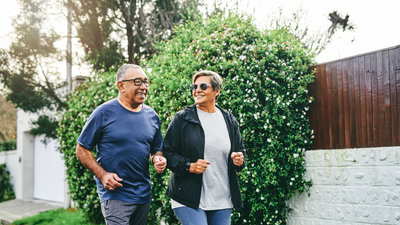New trends in home oxygen therapy: connectivity and portability
Published on September 29, 2022
5 minutes

Technological innovations drive better outcomes by making the use of oxygen for patients easier
The home oxygen therapy industry continues to make significant advances towards oxygen therapy solutions with new innovations that include:
1. Remote patient monitoring solutions
2. Equipment improvements that enhance efficiency
3. Connectivity
4. Portability
5. Durability
These technological innovations for home oxygen therapy have the potential to drive better outcomes by making the use of oxygen for patients easier and improving therapy adherence.
Increased demand for remote oxygen therapy monitoring
The COVID-19 pandemic is also creating increased demand worldwide for home-based monitoring and patient engagement solutions. Remote oxygen therapy patient monitoring solutions have the potential of generating connectivity through oxygen equipment and mobile device apps, and provide clinicians with vital patient data while also ensuring that the equipment is being used in the manner prescribed.
This trend of digital health data transmission is expected to grow exponentially as wearable technology advances with innovations in Photoplethysmography (PPG) sensors and wireless 5G communications.
PPG is a non-invasive technology that uses a light source and a photodetector at the surface of skin to measure the volumetric variations of blood circulation. Wearable PPG sensors can only be placed at certain body locations such as:
● Fingertips
● Earlobes
● Forehead
While these are the most common, researchers are considering other body locations such as wrists for more convenient alternatives.
More recently, there has been interest from numerous researchers around the world to extract further valuable information from the PPG signal in addition to heart rate estimation and pulse oximetry readings. The increased use and adoption of remote patient monitoring solutions, with appropriate education on their use, can help patients be more engaged in the effectiveness of their care.
Home oxygen therapy provides a cost-effective alternative for payers and an improved quality of life for patients
As patients have moved from hospital to home, home oxygen therapy has provided a cost-effective alternative for payers and an improved quality of life for patients. Most long-term oxygen therapy (LTOT) patients have mobility and the demand for more portable oxygen solutions has increased in recent years.
In 2018, the American Thoracic Society conducted an online survey that included responses from 1,926 adult supplemental oxygen users in the United States. One-half of the respondents reported having “problems” with their lack of portable options (especially for travel), and lack of physically manageable and high-flow options. Seventy percent of respondents reported that they had no more than 4 hours of portable oxygen supply, yet 81% of respondents reported that they desired more than 5 hours.
Fortunately, there have been big strides made by oxygen concentrator manufacturers over the course of the last decade to improve oxygen concentrator’s high flow capacity, reliability and portability. Portable oxygen concentrators (POC) were developed decades ago, but were cumbersome, unreliable and had limited autonomy (2-3 hours). Portable oxygen concentrators mechanically function the same way stationary concentrators do, by filtrating and converting oxygen at room air into higher concentration levels. Where the difference occurs is that they are smaller in size and are more suitable for travel. They are lightweight enough to move freely and compact enough to be taken in a car, bus or plane.
New portable oxygen therapy solutions are on the rise
There is no doubt that patients want the lightest, longest-lasting portable oxygen solutions. Portable home oxygen therapy equipment used to have a lower therapy adherence by patients, as they do not want to lug around a bulky, industrial-looking oxygen system. However, increasing battery life is one of the areas where there have been significant advances, thanks to innovations in lithium-ion battery technology and oxygen conserving techniques in recent years.
Today’s portable oxygen concentrators offer a whole new level of freedom that we have never seen before for active oxygen patients. The latest portable oxygen concentrator devices can charge their batteries to get up to 8-13 hours of oxygen therapy depending on the individual patients’ liter flow settings, while only weighing as little as 5-7 pounds. When the batteries are depleted, users can also swap in an extra battery, or plug their concentrators into an AC (wall outlet) or DC (car) power source to use their POCs while charging the batteries.
Portable oxygen concentrator manufacturers are also working towards silent compressor motors, allowing for minimal noise pollution in confined spaces. By enhancing performance features, portable oxygen concentrator manufacturers have enabled recent designs to expand the units’ durability beyond periodic use and become dependable and durable for a consistent five-year cycle, while helping to maintain oxygen saturation better at all activity levels with the most efficient use of dosing technology.
How the LTOT industry achieves optimal results for POC patients?
The effectiveness of long-term oxygen therapy depends on appropriate use of clinical skills as well as the utilization of the latest technological advances to maximize quality-of-life and health outcomes for the home oxygen patient, while reducing the overall cost of care.For more information about home oxygen therapy, check out our blogs:
- How to get started with home oxygen therapy.
- Do’s and Don'ts of Using Home Oxygen Equipment.
- Living With Oxygen Therapy On a Day-to-Day Basis
If you have any concerns about oxygen therapy, or need assistance during your oxygen therapy, the clinical team at VitalAire is here for you. Contact your nearest VitalAire Clinician.
References:
Ernst & Young LLP (EY), 2014. Connecting Patients with Providers. A Pan-Canadian Study On Remote Patient Monitoring. Canada Health Infoway (Infoway).
Castaneda D, Esparza A, Ghamari M, Soltanpur C, Nazeran H. A review on wearable photoplethysmography sensors and their potential future applications in health care. Int J Biosens Bioelectron. 2018;4(4):195-202. doi:10.15406/ijbsbe.2018.04.00125
Jacobs SS, Lindell KO, Collins EG, Garvey CM, Hernandez C, McLaughlin S, et al. Patient perceptions of the adequacy of supplemental oxygen therapy: results of the American Thoracic Society Nursing Assembly Oxygen Working Group Survey. Ann Am Thorac Soc 2018;15:24–32
McCoy R, Carlin B. Product performance variability with home portable oxygen systems may impact patient performance outcomes: it may be the device, not the disease. Respir Care. 2009;54:324-6.


